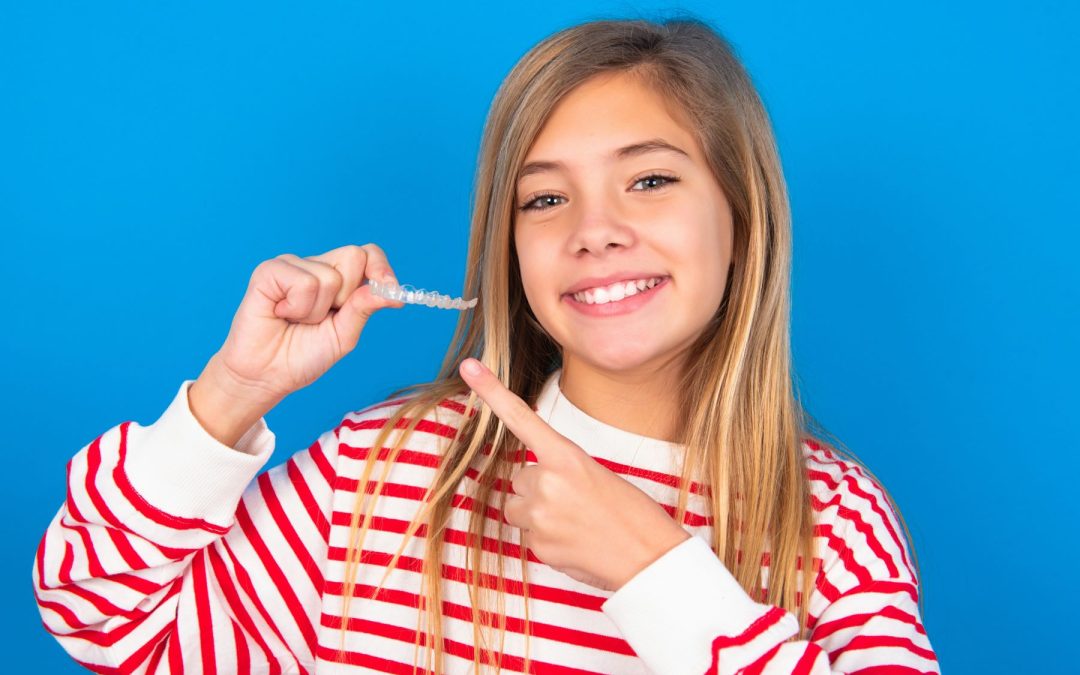More families are considering Invisalign for children or teens needing orthodontic treatment not only for esthetics, but also because of the ease of care and cleaning, the flexibility it offers young lifestyles, fewer appointments, and the benefits of early intervention in younger children.
1. What is Invisalign and How Does It Work?
Invisalign is a series of clear, custom-fitted, removable aligners that fit over a patient’s teeth like a thin, close-fitting mouth guard. These aligners are engineered to incrementally move a patient’s teeth over time to their ultimate desired positions. Because there are no brackets or wires, there are no problems with broken braces and patients don’t have to avoid certain foods— they can eat whatever they want. Some patients refer to these aligners as “invisible braces,” which generally follow these guidelines:
- Each aligner is typically worn for 1 week, then replaced by the next aligner in the series
- If an aligner is lost or broken, the patient simply moves to the next aligner
- Daily wear time is 20 hours per day
- Total number of aligners in the series depends on the particular orthodontic problems
- Most patients will need temporary tooth-colored bumps or “attachments” placed on the teeth that help the aligners move the teeth properly
2. Benefits of Invisalign for Children and Teens Compared to Braces
Children and teens who are candidates for Invisalign are often drawn to the advantages Invisalign offers over ceramic (clear) or traditional metal braces. Advantages include:
- Ease of tooth and gum care. Aligners are removed to floss and brush the teeth, making both jobs much easier than with ceramic or metal braces
- More comfort for lips and cheeks compared to braces which can sometimes irritate the lips and cheeks
- More esthetically pleasing to many teens and children as aligners are almost invisible over the teeth
- No dietary restrictions as aligners are removed to eat
- Musicians can remove aligners to practice wind instruments
- Athletes can remove aligners to wear sports guards for protection
- Fewer unexpected trips to the office for wire replacements or adjustments and fewer scheduled appointments in general
- No messy impressions as a comfortable scanner is used to create a 3-D model of the patient’s teeth and bite
3. Young Children’s Developing Mouths Can Benefit from Invisalign
Invisalign can address young children’s orthodontic issues by correcting or preventing misalignment of teeth as they grow in, addressing the effects of thumb sucking, correcting bite issues, and shortening the time a child may need to wear braces in the future. Invisalign can also widen dental arches to create more space for the erupting permanent teeth.
4. How Long Does Invisalign Take to Straighten Teeth?
The total treatment time required is typically the same length of time as traditional braces. The exact length of time is dependent on the issues that need to be corrected.
5. Is Invisalign an Option for All Children and Teens?
While many kinds of orthodontic issues can be resolved with Invisalign, there are some desired tooth movements and jaw corrections that are not possible with aligners and require traditional braces. In addition, there are particular orthodontic situations that are just better treated with traditional braces.
So, before even offering Invisalign as an option to traditional braces, your orthodontist or dentist will:
- Do a thorough evaluation of your child’s teeth, bone structure and jaw
- Present an overview of your child’s particular orthodontic issues
- Discuss your child’s best options and whether Invisalign for children and teens is one of your options for consideration
6. Compliance is Essential for Successful Outcomes for Children and Teens Using Invisalign
If your child is an ideal candidate for Invisalign, an important variable to consider is compliance. To achieve success, Invisalign aligners need to be worn 20 hours per day throughout the duration of the treatment. If your child’s lifestyle does not permit the consistent wearing of the aligners due to frequent and lengthy sports or music practice obligations, or if you think your child won’t keep up with the required 20 hour per day wear, traditional braces are probably the better option.
It’s important to have an honest discussion with your child about the likelihood of compliance before choosing Invisalign to avoid disappointment with the results.
7. Invisalign is only as Effective as the Skilled Professional Administering It
Moving teeth and aligning your child or teen’s jaw requires comprehensive knowledge of the physiological processes that can safely and predictably move teeth into a new, healthy, straightened position. Invisalign is a tool and a technology. More important than the type of treatment (braces or aligners) is the expertise of the professional administering your child’s treatment.
At Walton & Maready Orthodontics in Raleigh, NC, we offer the expertise, experience, and professionalism that every parent wants for their children’s and teen’s dental and orthodontic care. In addition, we bring an exceptional level of dedication and commitment to individual attention to achieve the highest level of satisfaction for each and every patient. We love working with children and teens to help give them beautiful, confident smiles!

